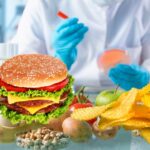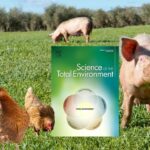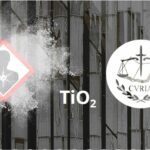
Nano and food

Dossier: Nanos in food
By the AVICENN team – Last modification January 2023
In 2020, ANSES had identified more than 900 food products in which the presence of nanos is proven (the figure rises to 4,300 products including those where the presence of nanos can only be suspected). These nanos added in foodstuffs are mainly intended to improve the appearance of food (color, texture), to modify the stability or fluidity of products in powder form or to increase the bioavailability of certain nutrients.
At the end a long collective work involving NGOs supported by AVICENN, the additive E171 (containing nanoparticles of titanium dioxide) was banned in food in France in 2020, then in all Europe in 2022.
However, if there is a European regulation for nanomaterials in food, everything is still far from being under control, especially because of insufficient traceability (the r-nano register does not identify finished products containing nanomaterials).
The various product tests carried out by associations or the fraud control department (DGCCRF) reveal the extent of the problem: very few nanos are labeled. Worse, some of them could be widely used and “off the radar” because they are covered by the labeling exemption for “technological adjuvants”.
Who benefits from nanos in food, what are the risks for our health, what recommendations have been issued, what are the current or future initiatives in the field? Discover our information sheets that we will complete and update as knowledge evolves: your contributions are welcome!
Other news on the topic
Upcoming Nano Agenda
- Spectacle Art & Science – When science changes as it passes from mouth to mouth
- A unique participatory experience centered on the human factory of knowledge, where two fascinating worlds meet: nanomedicine, with its nanoparticles and cellular nanovectors, and quantum physics, with its superimposed states and complex systems.
- Organizers: Centre National de Compétences en Nanosciences (C’Nano), in collaboration with the Commissariat à l’Énergie Atomique (CEA), the Institut Polytechnique de Paris (IPP) and the Centre National de la Recherche Scientifique (CNRS).
- Speakers: Florence Gazeau, academician, physicist, research director at CNRS, and Charles Antoine, PhD in physics, lecturer at Sorbonne University, and Albert Moukheiber, PhD in neuroscience.
- Location: Théâtre de la Ville
- Website: https: //www.theatredelaville-paris.com/…/rencontres/nano-rumeurs…
- 8th Congress of Occupational Medicine and Health (CNMST 2026)
- Theme 5: Emerging pathologies and risks, Mr Henri Bastos (ANSES), Pr Lynda Bensefa-Colas (AP-HP), Dr Catherine Nisse (CHU Lille)
- Website: www.medecine-sante-travail.com
- 20th meeting of the “nano and health” dialogue committee
- Organizer: ANSES
Any questions or comments? This information sheet compiled by AVICENN is intended to be completed and updated. Please feel free to contribute.
This file was originally created in May 2013.







